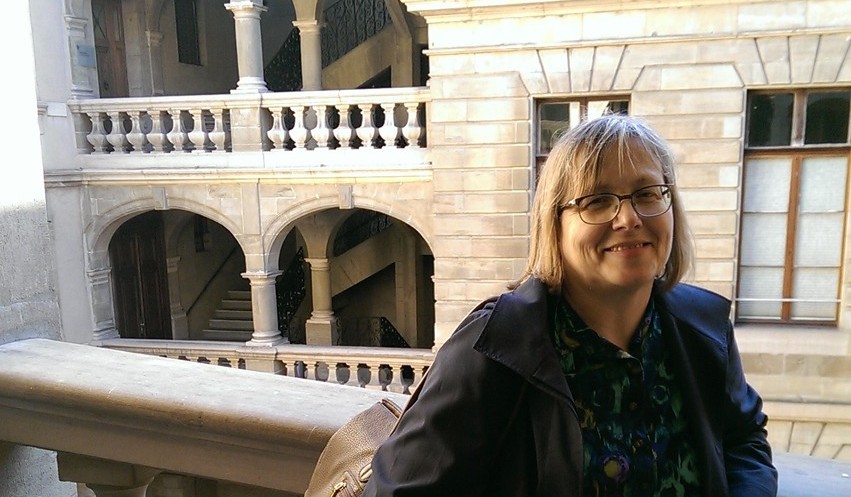By Sarah Tuff Dunn
When she left Warsaw, Poland, with a master’s degree in animal science from the city’s University of Agriculture, Elzbieta Zakrzewska—who goes by Ela—flew all the way across the United States to study avian genetic mutations while earning her PhD from Oregon State.
Ever since, wings and other living things have been a predominant theme for the public health expert, who now works for Blue Cross Blue Shield in Berlin, Vermont, as a senior analyst. There have been papers on the genetic mutations in birds and starter diets of male turkeys, plus presentations on prepartum rats in hypergravity.
It was animal nutrition and endocrinology, in fact, that connected Zakrzewska to UVM, where she began researching chicken growth and organ development when she and her husband, who had been hired for a new job at Goodrich, moved to Vermont after a four-year return to Poland.
UVM also allowed Zakrzewska to be part of a NASA-sponsored project on examining how gravity affects hormones and metabolism. In 2015, she pursued the UVM Master of Public Health Program and now reveals how it feeds her own career.
What was it like to work on that NASA project?
It was very exciting—I spent quite a lot of time working and living on the NASA base in California. I analyzed hypergravity-induced metabolic changes in adipose tissue. Many people don’t realize it, but the boring blob of fat is all but boring. It’s a very active tissue no organism can exist without.
How did you end up working for Land O’Lakes in Poland?
They needed a new nutritionist designing new feeds for the Polish market, someone who knew fluent English, had a degree from a US university, knew the reality of a US company, and could apply it all while speaking native Polish. So they got me. I enjoyed my work there since I could do some research and apply my knowledge in an industry.
How did UVM’s MPH program help your career?
Recent exposure to medical fields had opened my mind to new possibilities—work in public health. I truly enjoyed subjects related to public health law, policies, or health insurance. Now, with the MPH under my belt, I feel better prepared to help Vermonters in improving their life.
You now work for Blue Cross Blue Shield Vermont. What are some of the biggest challenges of your job?
I analyze a lot of data related to mental health and substance abuse. We all are aware of the opiate and prescription drug addiction crisis in Vermont. One of the biggest challenges anyone in this line of work faces every day is integration of mental health and medical needs for Vermonters. I’m responsible for providing sound data to check whether such integration and easier access to mental health support is optimal.
And the biggest rewards?
Interestingly, my biggest rewards are usually connected to my interactions with students. I taught at UVM for a few years. I also mentored few students during their Honors College theses and trained them in the lab. There’s no better reward than seeing students develop, learn, and be challenged and be proud of their accomplishments. I’m happy to hear from them, to see them fulfilling their dreams, whether going to medical or vet school. In my current work, seeing in numbers that actions undertaken to help BCBSVT members really work makes me happy.
What advice do you have for people wanting to work in public health?
Whether pursuing public health or other fields, always do your research. Find out whether this is something that you can spend part of your life doing. Never allow anybody to stop you from fulfilling your dreams. It is never too late to learn something new. I got my PhD in 1996, 20 years ago! When I told people that I was going for the MPH, some said, “But why? You have your PhD; you are done.” No, you are never done. Whether you learn on your own or in a structured program, you improve your life and other people’s lives. This approach allows you to be flexible in case there is a need to change your career.
Your paper topics—such as “organ and body growth in full-fed and pair-fed chickens consuming raw and heated velvet beans”—are quite esoteric. How do you come up with them?
The title is usually related to the area of study. In this case, the simplest explanation in lay language is that velvet beans are good source of protein, but untreated ones also contain toxic substances. Heating reduces the amount of these toxins and makes the beans safer.
You’ve authored many publications and presentations. How do you balance your time?
When you work as researcher, writing grants and papers is a part of your work. No scientist works eight hours per day. We all work all day; sometimes the best ideas or solutions come to us during dinner or a walk. I have been called a workaholic by my kids, and they have refused to have a career in life sciences, hoping that computer sciences are less demanding. Ha, ha. Surprise!





